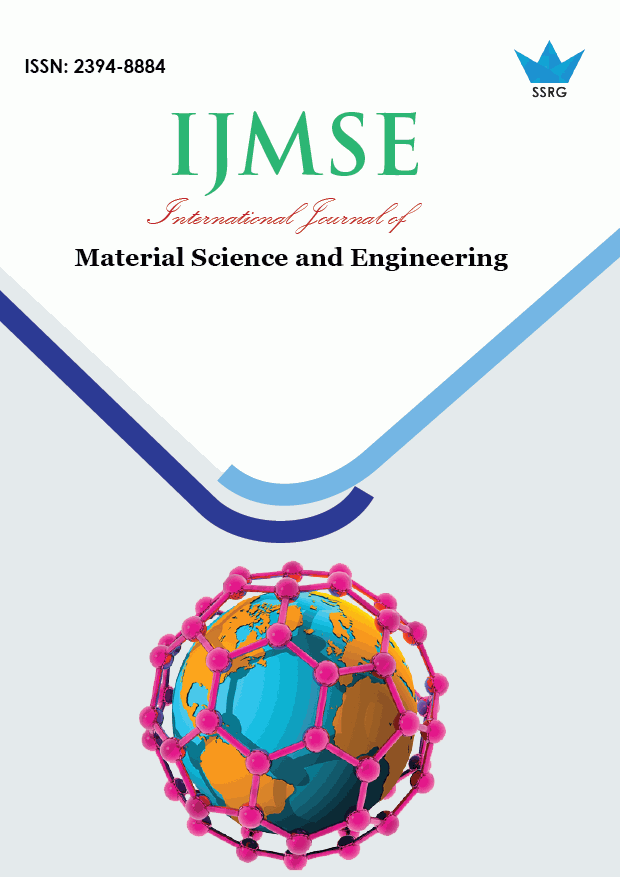An experimental study on the comparison of crystallization behavior and structure of some Fe-B-Si-Cu-Nb and Fe-Tm-B alloys

| International Journal of Material Science and Engineering |
| © 2020 by SSRG - IJMSE Journal |
| Volume 6 Issue 1 |
| Year of Publication : 2020 |
| Authors : B. Bhanu Prasad, M.D.V. Srilalitha |
How to Cite?
B. Bhanu Prasad, M.D.V. Srilalitha, "An experimental study on the comparison of crystallization behavior and structure of some Fe-B-Si-Cu-Nb and Fe-Tm-B alloys," SSRG International Journal of Material Science and Engineering, vol. 6, no. 1, pp. 5-10, 2020. Crossref, https://doi.org/10.14445/23948884/IJMSE-V6I1P102
Abstract:
An experimental study is made to understand the crystallization behavior and structure of amorphous Fe68.8B9.5 Si18.6Cu0.5 Nb2.6 (S1), Fe73.5 B9 Si13.5 Cu1 Nb3 (S2), Fe78Tm2B20 (S3) and Fe76Tm4B20 (S4) alloys using Differential Scanning Calorimetry (DSC), X-ray Diffraction (XRD) and Scanning Electron Microscopy (SEM). DSC curves of amorphous Fe68.8B9.5 Si18.6Cu0.5 Nb2.6 (S1)and Fe73.5 B9 Si13.5 Cu1 Nb3
(S2) showed two-step crystallization. A wide region that occurs between the two crystallization stages ensures the useful properties of the material before boride formation. Comparing these results with XRD results, these two peaks represent the growth of the crystalline phases of α-Fe(Si) at peak 1 and Fe3Si at peak 2. In amorphous Fe78Tm2B20 (S3) and Fe76Tm4B20 (S4) alloys, the crystallization is a multi-stage process where different crystalline phases grow in the amorphous matrix. Our study shows that when Tm 2% and 4% are added to Fe-B alloys, the crystallized ribbons consists of α-Fe and Fe3B.
Keywords:
DIFFERENTIAL SCANNING CALORIMETRY, X-RAY DIFFRACTION, CRYSTALLINE PHASES, AMORPHOUS FERROMAGNETS.
References:
[1] C.A. Schuh, T.C. Hufnagel and U. Ramamurty, Acta Mater. 55 (2007) 4067
[2] A.L. Greer, Y.Q. Cheng, and E. Ma, Mater. Sci. Eng. R 74(2013) 71.
[3] C. Suryanarayana and A. Inoue, Int. Mater. Rev. 58 (2013) 131
[4] L. Xia, K.C. Chan and M.B. Tang, J. Alloys Compd. 509(2011) 6640.
[5] M. Zhao, K. Abe, S.I. Yamaura, Y. Yamamoto and N. Asao, Chem. Mater. (2014) 1056
[6] A. Inoue, X.M. Wang and W. Zhang, Rev. Adv. Mater. Sci. 18(2008) 1
[7] Akihisa Inoue and Nobuyuki Nishiyama, MRS Bulletin, 32 (2007) pp. 651-658
[8] J.S. Dugdale and D. Pavuna, Endeavour, 9 (1985) pp. 62-66
[9] Y. Naitoh, T. Bitoh, T. Hatanai and A. Makino, J. Appl. Phys. 83 (1998) 6332
[10] Akhiro Makino and TeruoBitoh, J. Appl. Phys., 81(1997) 2736
[11] A. Makino, A. Inoue and T. Masumoto, Mat. Trans, JIM, 36 (1995) 924
[12] K. Hono, K. Hiraga, Q. Wang, A. Inoue and T. Sakurai, Acta Metall. et Mat. 40 (1992) 2137
[13] A.R. Bhatti and B. Cantor, J. Mater. Sci. 29 (1994) 816.
[14] K. Chrissafis, M.I. Maragakis, K.G. Efthimiadisand E.K.Polychroniadis J. Alloys Compd. 28 (2004) 375.
[15] K.G. Efthimiadis, E.K. Polychroniadis, S.C. Chadjivasiliouand I.A.Tsoukalas, Mater. Res. Bull. 35 (2000) 937.
[16] K.G. Efthimiadis, G. Stergioudis, S.C. Chadjivasiliouand I.A.Tsoukalas, Cryst. Res. Technol. 37 (2002) 827.
[17] I. Matko, P. Duhaj, P. Svecand D.Janickovic, Mater. Sci. Engg., A 179/180 (1994) 557.
[18] F. Zhou, K.Y. He and M.L. Sui, Mater. Sci. Engg., A 181/182 (1994) 1419.
[19] J.D. Ayers, V.G. Harris, J.A. Sprague and W.T. Elam, Appl. Phys. Lett.64 (1994) 974.
[20] Y.R. Zhang and R.V. Ramanujan, Thin Solid Films 505 (2006) 97

 10.14445/23948884/IJMSE-V6I1P102
10.14445/23948884/IJMSE-V6I1P102